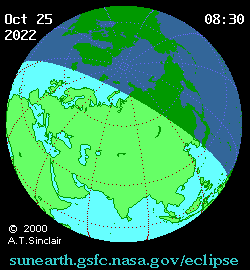Watch the last solar eclipse of 2022 for free today
The sun will appear as if a monstrous bite has been taken from it — but only from some parts of the planet.
Today, Earth will experience a partial solar eclipse that will be visible from parts of Europe, western Asia, and northeast Africa. Skywatchers in other parts of the world, such as the U.S., may miss this event in person, but they can watch it live online for free.
The partial solar eclipse will begin on Tuesday, Oct. 25, at 4:58 a.m. EDT (0858 GMT) on Oct. 25 when the moon passes in front of the sun and will end at approximately 9:01 a.m. EDT (1301 GMT).
Solar eclipses occur when the moon slips between Earth and the sun casting a shadow on the planet and fully or partially blocking sunlight. The Oct. 25 partial eclipse is the second partial eclipse of 2022, with the last occurring on April 30 and sweeping across the southeast Pacific and southern South America.
Related: Solar eclipses 2022: When, where & how to see them
Neither partial solar eclipses nor total solar eclipses are ever visible from all parts of the Earth. This is because the moon is much smaller than Earth and its shadow is just a few hundred miles wide, meaning it can only fall on part of the planet's surface at any one time.
The maximum the disk of the sun will be covered on Oct. 25 is 82% at a location called "the point of central eclipse." This is the place on Earth at which an imaginary line connecting the center of the sun and the center of the moon meets our planet's surface.
During the Oct. 25 eclipse, the point of central eclipse will be at the North Pole. Moving from here, regions farther away from the point will see less and less of the sun's disk eclipsed. In Russia, 80% of the sun will be eclipsed, with this shadowy region dropping to 70% in China, 63% in Norway, and 62% in Finland.
Get the Space.com Newsletter
Breaking space news, the latest updates on rocket launches, skywatching events and more!
Read more: The 1st solar eclipse of 2022 is stunning in these satellite views

This eclipse won't be a total solar eclipse anywhere in the world because during the event the moon and sun will not be perfectly aligned, thus there's nowhere on Earth the moon will completely cover the sun.
This means that the sun will appear like a monstrous bite has been taken out of it, a great image in the lead-up to Halloween.
If skywatchers miss this opportunity to see the partial solar eclipse either in-person or online, then they will want to set a reminder for April 20, 2023, when the next total solar eclipse will occur.
Royal Observatory Greenwich livestream
Royal Observatory Greenwich will host a livestream of the partial solar eclipse on their YouTube page. The livestream will begin at 5:05 a.m. EDT (0905 GMT) on Tuesday (Oct. 25 ). According to the observatory, the stream will feature "detailed telescope footage and expert astronomy commentary" and will use the Annie Maunder Astrographic Telescope housed at the Royal Observatory.
Visit the Royal Observatory Greenwich's solar eclipse page for more information.
The Virtual Telescope Project livestream
The Virtual Telescope Project 2.0 will allow astronomy enthusiasts to watch the partial solar eclipse on Oct. 25 from the comfort of their homes (or offices) starting at 5 a.m. EDT (0900 GMT).
Astrophysicist Gianluca Masi of the Project will host the eclipse from Ceccano, Italy, and the event can be livestreamed online for free at the project's website or on its YouTube channel.
Time and Date livestream
The mobile observatory team of the website Time and Date will also live stream the partial eclipse and the coverage will be available to watch on its YouTube channel starting at 4:30 a.m. EDT (0830 GMT).
Time and Date will also have a live blog featuring real-time reports and background information about the partial solar eclipse.
Editor's Note: If you get a good photo of the partial solar eclipse and would like to share it with Space.com's readers, send your photo(s), comments, and your name and location to spacephotos@space.com.
Follow us on Twitter @Spacedotcom or on Facebook.
Join our Space Forums to keep talking space on the latest missions, night sky and more! And if you have a news tip, correction or comment, let us know at: community@space.com.

Robert Lea is a science journalist in the U.K. whose articles have been published in Physics World, New Scientist, Astronomy Magazine, All About Space, Newsweek and ZME Science. He also writes about science communication for Elsevier and the European Journal of Physics. Rob holds a bachelor of science degree in physics and astronomy from the U.K.’s Open University. Follow him on Twitter @sciencef1rst.